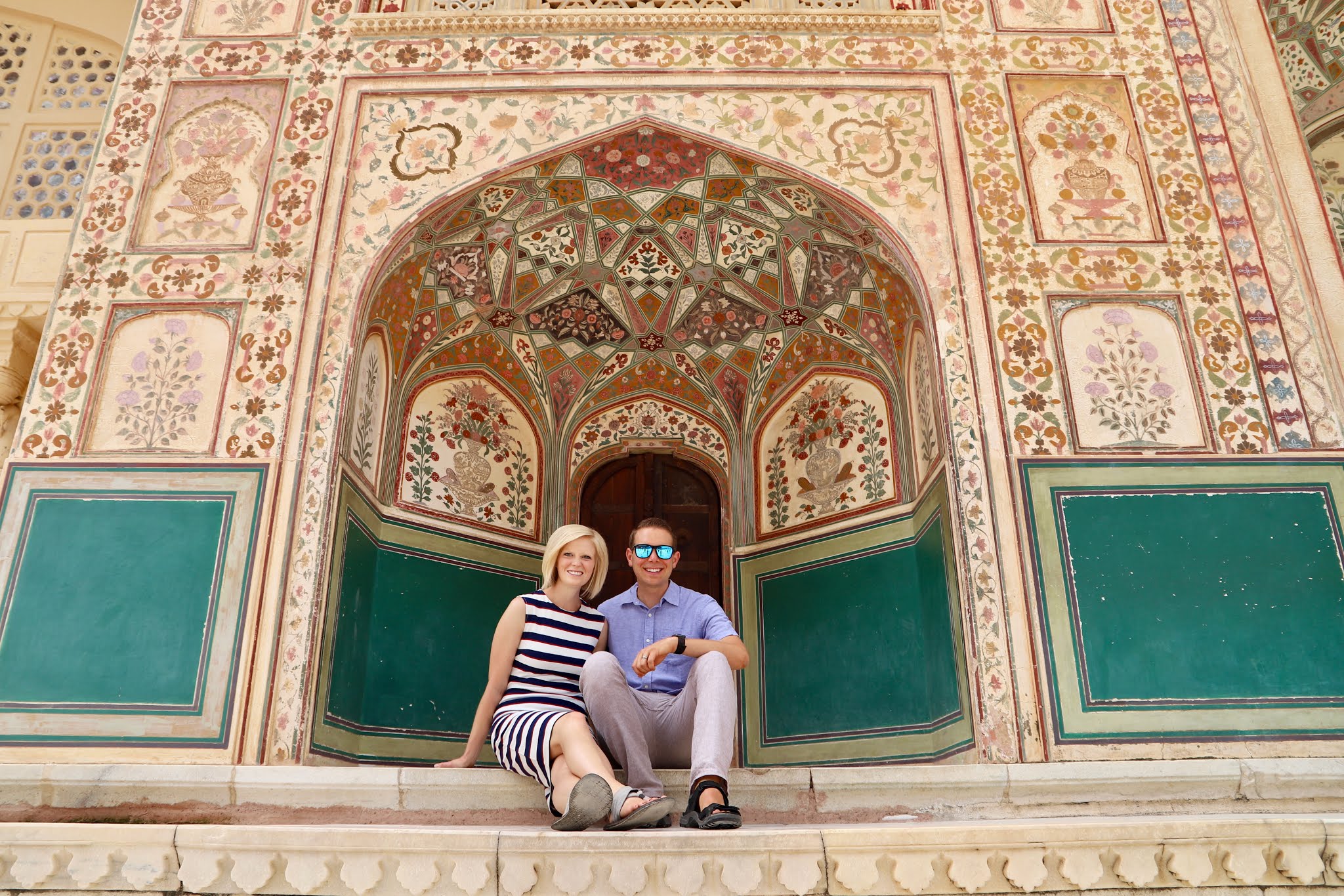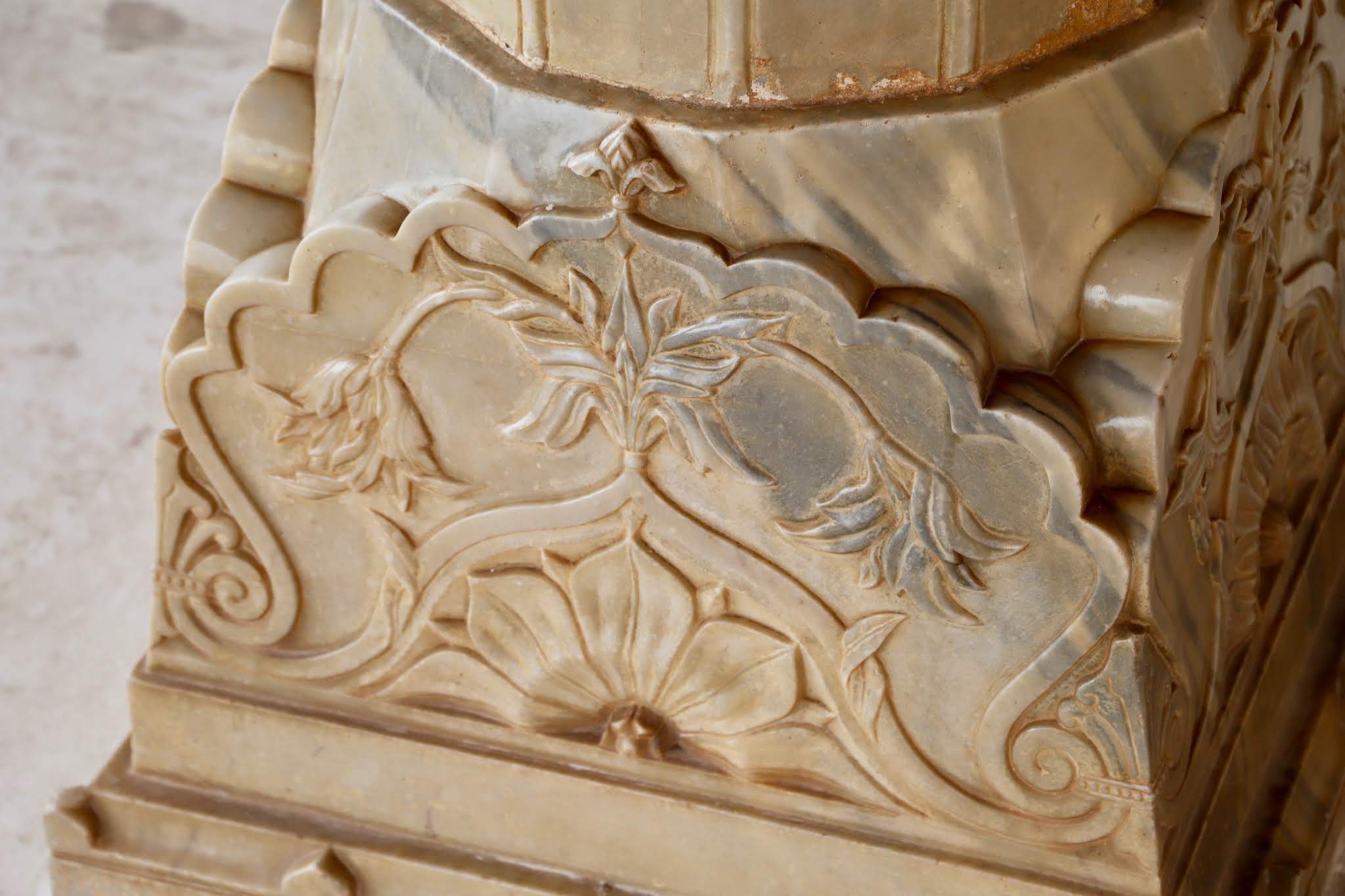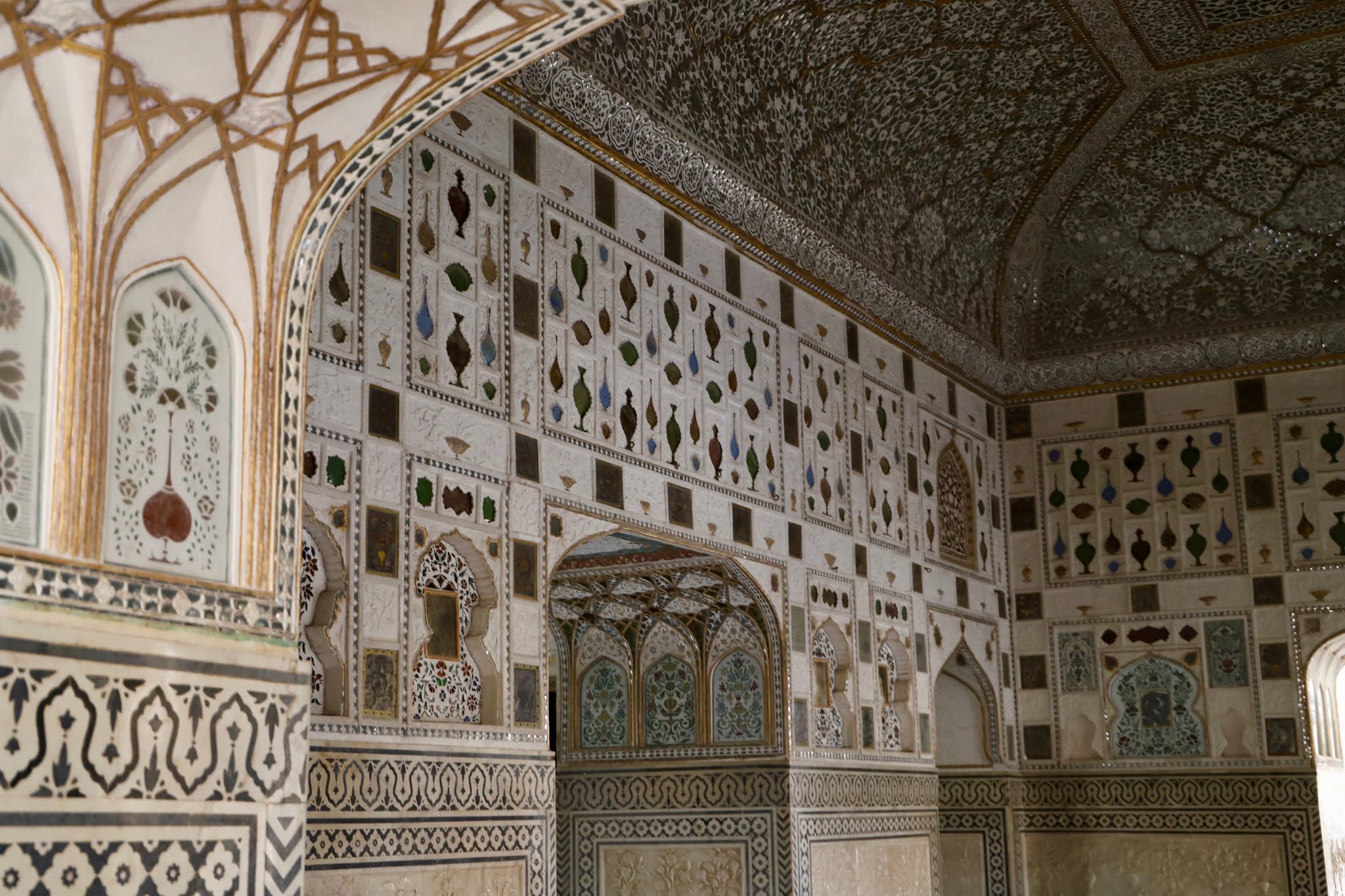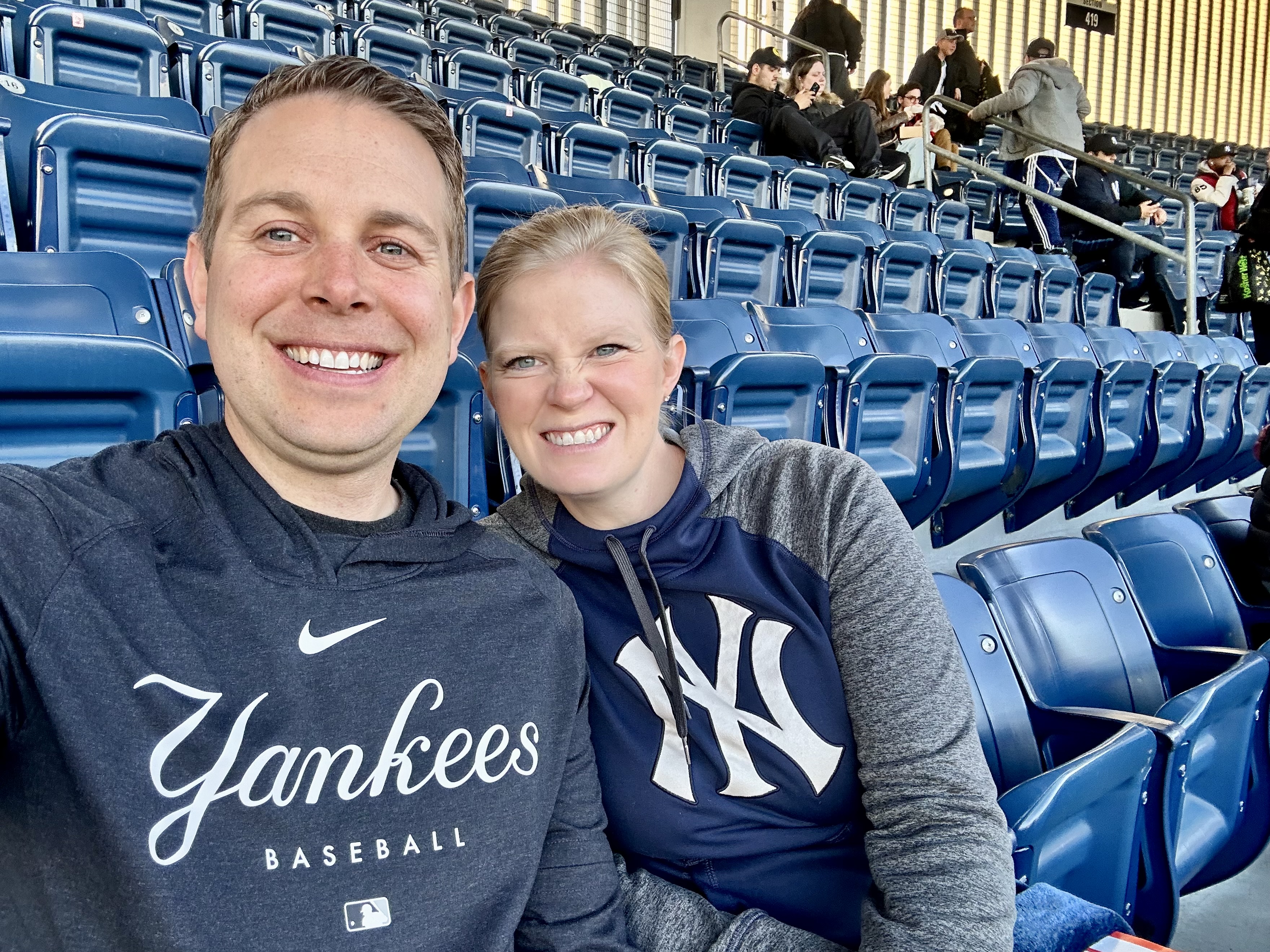Day 8 - Jaipur
Today was a wonderful day in Jaipur! Jaipur is called the pink city because all of the buildings in the old city have to be painted the same color as Terracotta Pink. It makes for an interesting and beautiful city! Our guide Sharma picked us up promptly at 8:30 and we made our way into the old city. Sharma was incredibly knowledgeable. He teaches at a University and guides tours part-time and it was easy to see his passion for the city.
Our first stop was the Hawa Mahal. This was built by the King of Jaipur in the nineteenth century for his wives. The building is beautiful, but it's simply a facade - the first two levels allowed the wives to see out the windows into the outside world, but behind the rest of the levels there is simply air. The Queens at that time were not able to walk about freely in the city, so this enabled them to see what was happening. India had many Kingdoms at the time of their rule by both the Mughals and the British. When they received their Independence from England in 1947 Lord Mountbatten worked with each of the individual Kingdoms to ensure they would honor the new state and not seek power for their own. As such, each of the royal families ceded their power, but they were able to keep their land and titles. There is still a Royal Family in Jaipur today, 13 royal families in Rajasthan, and approximately 600 royal families in all of India.
After the Hawa Mahal, we visited the Amber Fort. This was built as the Palace for the Royal Families in the seventeenth century. Our driver dropped us off at the bottom of the hill where Eric took pictures and made friends with a snake charmer. I was not impressed. I hate snakes and refuse to go near them. We took a jeep to the top of the hill through the old city. Many people ride elephants to the top, but I absolutely refused. Riding elephants is animal abuse and it broke my heart to see the elephants up there. Elephants are not meant to be ridden under any circumstances and humans should be responsible when thinking about animal tourism (I'm looking at you, Seaworld).
One of the early Kings of Jaipur married a Muslim woman - this was huge for their kingdom and was the first marriage of its kind because the King was Hindu. As a result, many areas of the Fort have Indo-Islamic Architecture. For example, one of the courtyards has sandstone columns created by Hindus and also marble columns created by Muslims. The top of each of the columns has Hindu art and the bottom has Muslim art. I loved this example of coexisting. Above all of the columns was the God Ganesh with a lotus flower in his trunk. Ganesh is also featured prominently above many of the doorways as a symbol of good luck. Ganesh is the son of Vishnu, one of the main Gods of Hindus. I've learned a lot about Hinduism on this trip, but I still feel like I'm barely scratching the surface.
From the entrance of the Fort, you can see beautiful gardens below - the left side is Hindu art (lotus flowers) and the right side is Muslim art (stars). There was also a moat that went all around the fort that was filled with crocodiles to deter enemies. The monsoons would fill the moat every year and that is where the Royal Family would get their water. There were drainage systems throughout the Fort that took any disposed of water back to the moat since the Monsoon water had to last the entire year. The colors of the Fort were made to mimic the gemstones found locally in the area and they also used gold leaf in some of their paintings - the colors were so vibrant!
Further into the Fort, there was another garden - this is similar to the garden we will see tomorrow at the Taj Mahal! There were also two distinct areas in this palace - the winter palace and the summer palace. The Winter Palace is famous for having thousands of small mirrors. Outside of the palace, the mirrors are clear and inside they are brightly colored. The glass/mirror work was done by a Belgium craftsman - it was gorgeous! There were also amazing relief sculptures of flowers throughout the palace.
The summer palace was opposite of the winter palace - the methods they used to keep it cool were pretty amazing. One of the methods was to have a waterfall run throughout the middle of the palace, flow into the garden for irrigation, and then flow down to the moat to be recycled. Our next stop was the living quarters of the Royal Family. The King who built the fort had 12 wives, so there were 12 apartments for the Queens. Each has two bedrooms, a kitchen, a dining area, and a bath. The King's apartment was above his favorite wife's apartment, but he had staircases to each of the other apartments.
The art and architecture in India, especially Jaipur, are amazing. I was inspired to want to buy an art history book on Indian art and architecture. It's so beautiful and unlike any of the art/architecture we've seen anywhere else we have traveled.
After the Amber Fort, we visited Jal Mahal. This is a palace built on the water and was only used during the summertime by the Royal Family. Visitors were not able to go in, but it was very pretty to look at. Our next stop was lunch, which was delicious. Eric ordered mutton korma and I ordered some sort of chicken dish. They were both divine. For dessert, we ordered Gulab Jaman, which was delicious! We have had excellent food in India.
After lunch, we went to the City Palace. The Royal Family still lives in a part of this palace but has turned the rest into museums. It was really beautiful. The architecture and bright colors of the palace make it really beautiful. The first gallery we went to was a history of the Royal Family. We learned more about the Jaipur Royalty and saw their court. Our next stop was the textile museum where we saw clothes worn by the Royal Family throughout the ages. They were beautiful. Our next stop was my favorite stop of the day - an art market featuring local artists. They were all happy to demonstrate their crafts and I was struck by how many of the artists learned their skills from their parents or grandparents and were continuing in the family tradition. We bought a few things to do our part to encourage local art. We then went and saw weapons used in wars defending Jaipur (or also conquests of neighboring kingdoms). I hated this museum mostly because I hated seeing how creative people can be when their goal is to harm someone else.
Our next stop was the observatory. The first King of Jaipur enjoyed astrology and built many instruments to tell time and follow the stars. It was so cool to see - and also crazy that these instruments were built in the seventeenth century.
Our final stop of the day was a yoga class. I love practicing yoga and Eric often joins me. We went to our yoga instructor's house for the practice, which was really fun and interesting to see. She and her husband were both so welcoming and gracious - we absolutely loved spending time with them. Mita, our instructor, spent time explaining many mindfulness practices to Eric and me. Each of our fingers represents a different element (fire, air, sky, earth, and water) and by touching different fingers together, it signifies different things. For example, placing your thumb and first finger together, as seen in many types of meditation, conveys knowledge and energy because your thumb represents fire and your first finger represents air. By putting these two fingers together, you are creating energy and knowledge. She also explained different breathing techniques before we jumped into the yoga poses. I left with a much greater appreciation for mindfulness and meditation and a desire to do far more yoga in my life. It's such a beautiful form of exercise and can be simplified even for people who desire to exercise and create more mindfulness, but while they are still learning the skills and building strength. It's something that everyone can do.
We absolutely fell in love with Jaipur today and can't wait to explore more of India tomorrow!














































































Comments
Post a Comment